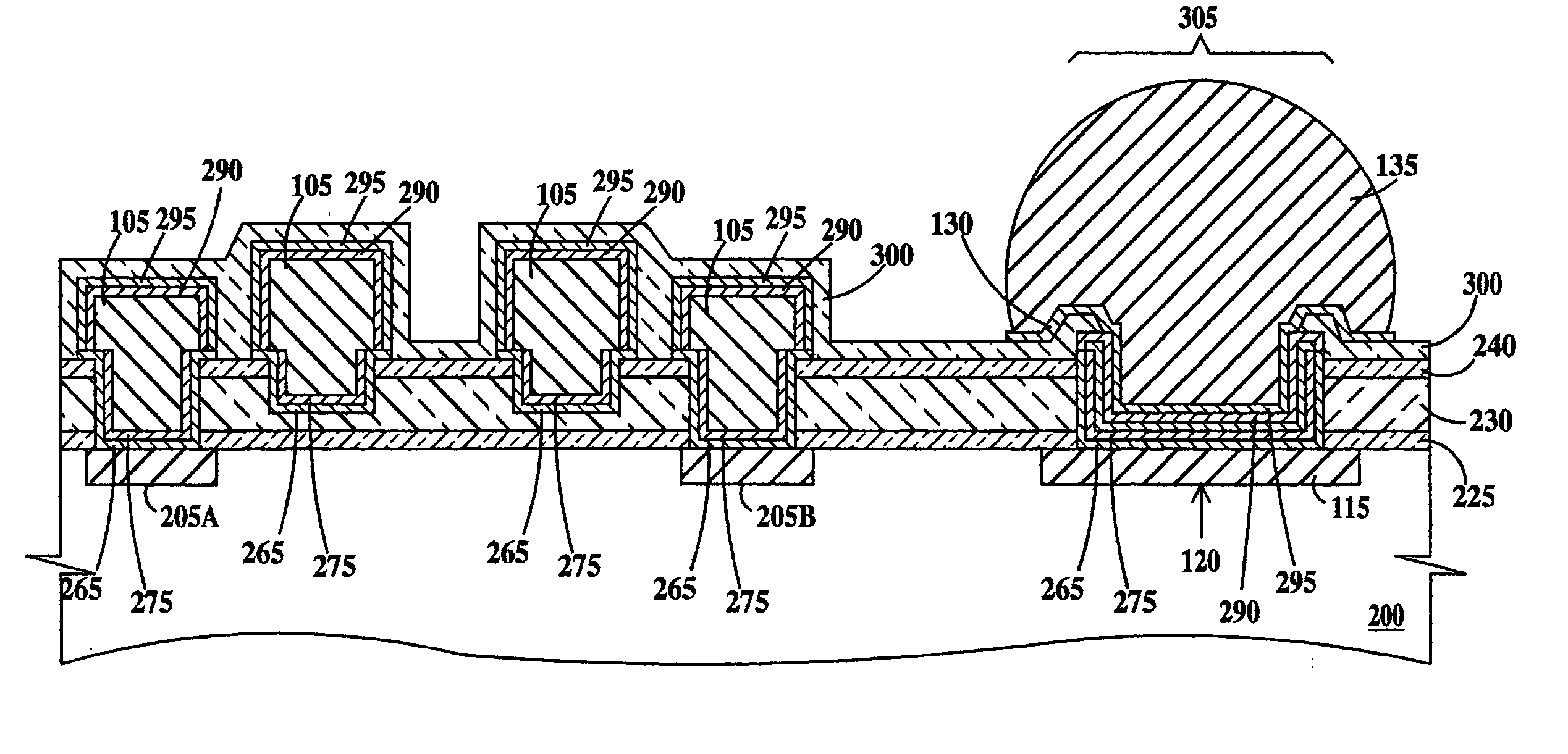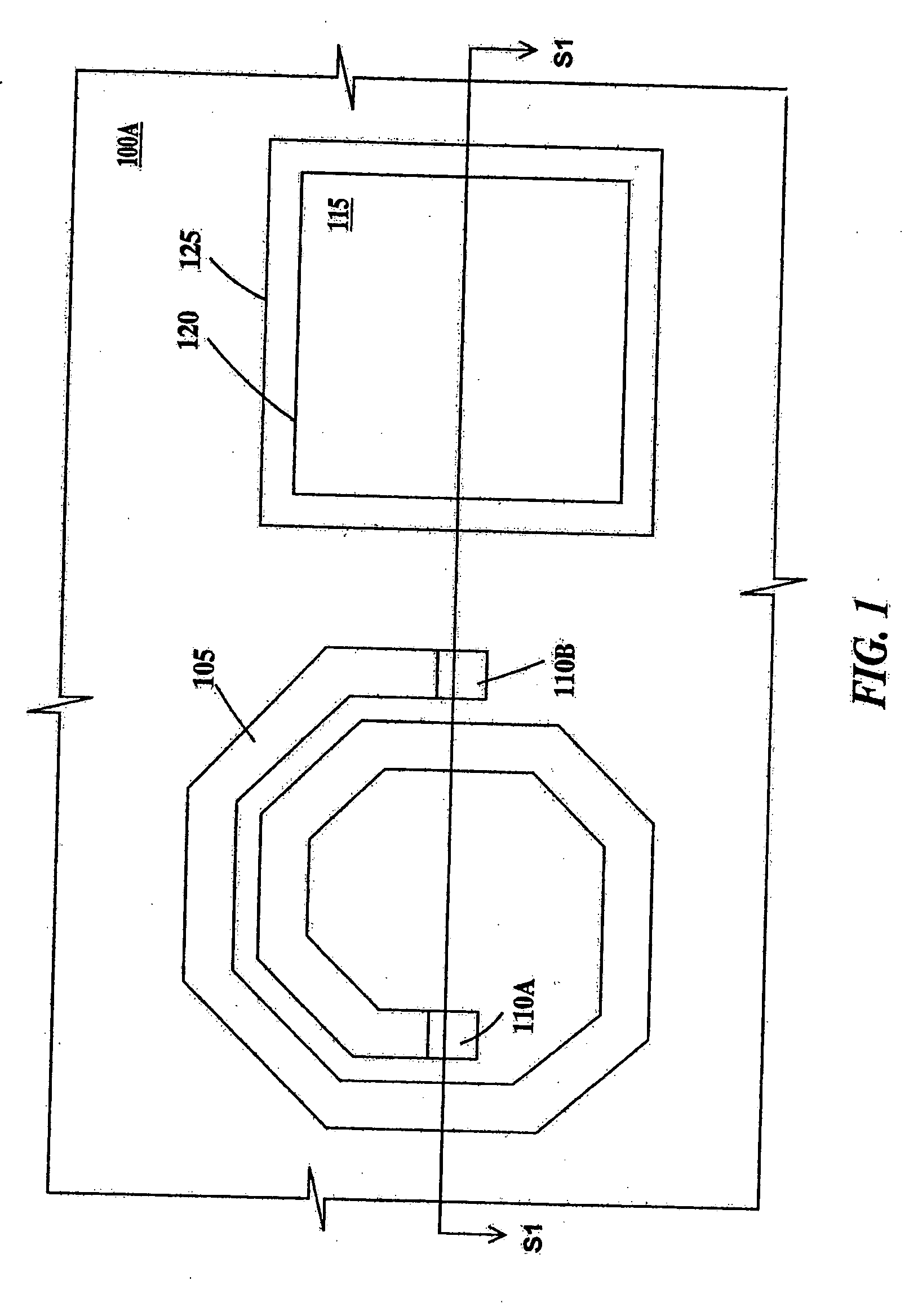High Q factor integrated circuit inductor
a high-quality, inductor technology, applied in the direction of transformer/inductance coil/winding/connection, transformer/inductance magnetic core, inductance, etc., can solve the problems of large integrated circuit chip surface area of metal lines inductors, power consumption increase, and inability to meet the requirements of high-quality inductors,
- Summary
- Abstract
- Description
- Claims
- Application Information
AI Technical Summary
Problems solved by technology
Method used
Image
Examples
first embodiment
[0015]FIG. 1 is a top view of an inductor and contact pad according is according to the present invention. In FIG. 1, an integrated circuit chip 100A includes an inductor 105 having integral vias 110A and 110B for interconnection to wiring levels (not shown) within the integrated circuit chip. While inductor 105 is illustrated as a spiral inductor the invention is applicable to inductors of other shapes as well. Integrated circuit chip 100A also includes an I / O terminal pad 115 in the bottom of a via 120 for interconnection to wiring levels (not shown) within the integrated circuit chip and a conductive passivation layer 125 formed on top of I / O terminal pad 115 and overlapping via 120.
second embodiment
[0016]FIG. 2 is a top view of an inductor and contact pad according is according to the present invention. In FIG. 2, an integrated circuit chip 100B includes inductor 105 having integral vias 110A and 110B for interconnection to wiring levels (not shown) within the integrated circuit chip. While inductor 105 is illustrated as a spiral inductor the invention is applicable to inductors of other shapes as well. Integrated circuit chip 100B also includes I / O terminal pad 115 in the bottom of via 120 for interconnection to wiring levels (not shown) within the integrated circuit chip, conductive passivation layer 125 formed on top of I / O terminal pad 115 and overlapping via 120, a pad limiting metallurgy (PLM) layer 130 and a solder ball 135 formed over conductive passivation layer 125. Solder balls are also known as controlled collapse chip connection (C4) balls, C4 solder balls and solder bumps. For the purposes of the present invention the term solder ball may be replaced with the ter...
third embodiment
[0017]FIG. 3 is a top view of an inductor and contact pad according is according to the present invention. In FIG. 3, an integrated circuit chip 100C includes inductor 105 having integral vias 110A and 110B for interconnection to wiring levels (not shown) within the integrated circuit chip. While inductor 105 is illustrated as a spiral inductor the invention is applicable to inductors of other shapes as well. Integrated circuit chip 100C also includes I / O terminal pad 115 in the bottom of via 120 for interconnection to wiring levels (not shown) within the integrated circuit chip, a conductive passivation coated raised pad 140 formed on top and overlapping via 120, PLM layer 130 and solder ball 135 formed over conductive passivation layer 125. PLM layer 130 is fully landed on raised pad 140.
[0018]FIGS. 4A through 4F are partial cross-sectional views illustrating fabrication steps common to the first, second and third embodiments of the present invention. FIGS. 4A through 4F may be ta...
PUM
 Login to View More
Login to View More Abstract
Description
Claims
Application Information
 Login to View More
Login to View More - R&D
- Intellectual Property
- Life Sciences
- Materials
- Tech Scout
- Unparalleled Data Quality
- Higher Quality Content
- 60% Fewer Hallucinations
Browse by: Latest US Patents, China's latest patents, Technical Efficacy Thesaurus, Application Domain, Technology Topic, Popular Technical Reports.
© 2025 PatSnap. All rights reserved.Legal|Privacy policy|Modern Slavery Act Transparency Statement|Sitemap|About US| Contact US: help@patsnap.com



